The morning after experiencing the
great
U2
concert at the Pond in
Anaheim, I found myself having to awake
at 5:30 AM to get myself to Los Angeles Union Station for the American
Public Transportation Association conference Alameda Corridor
tour departing at 8:00 AM. I wanted to somehow take public
transit to Union Station and decided to drive to the MTA Blue Line
Wardlow Station in Long Beach, about 10 miles west of my home. I
arrived just in time to see a Los Angeles bound Blue Line train get to
the station. I could not gather my belongings fast enough and buy
an
all day pass and catch that train. I asked a Long Beach transit
bus driver about how long until the next Blue Line train. She
replied that she was a bus driver and had no knowledge of Blue Line
schedules. After about a 15 minute wait, I boarded the Blue Line
at 6:36 which would still get me to the Red Line in downtown Los
Angeles and on to LAUPT with time to spare.
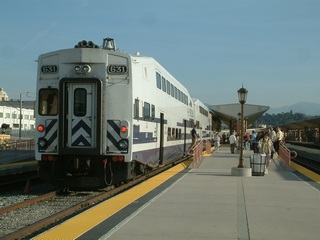
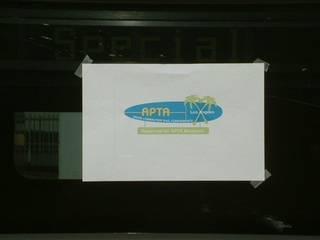
Arriving on platform 5 just about
7:30 AM, the Metrolink train was already there, having been deadheaded
in from Moorpark. APTA conference people and Metrolink officials were
already there. The continental breakfast was wheeled into the
cabcar at the trailing end of the train and soon one or two busloads of
people arrived. The special Metrolink train departed about 8:03
AM for San Pedro. This train also was the first Metrolink train
to traverse the Corridor. We crossed the Los Angeles River
to the east bank, headed south and then onto the Alameda
Corridor.
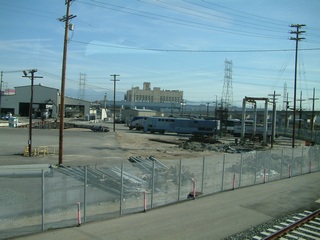
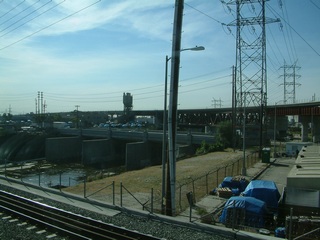
Soon after departure, Dan Davis from
the Alameda Corridor Transportation Authority started narrating
pertinent facts about the planning, construction and operation of the
Corridor. The Alameda Corridor consolidates rail traffic from 3
separate lines into one. All of the existing major railroads at
the inception of the plan had their own routes into the Ports of Los
Angeles and Long Beach. The route selected absorbed the Southern
Pacific line from downtown Los Angeles south to north Long Beach.
Union Pacific still maintains its line to the port but sends little or
no traffic on it. Santa Fe, Burilington Northern Santa Fe and now
the BNSF Railway also maintains its Harbor Subdivision, although it is
not a through route any longer. The corridor took several years
to build and has been operational for 2 years. It recovers costs
by charging the railroads $15 to $17 per TEU which is a standard twenty
foot size container. Containers which are trucked inland are also
assessed the same fee. 50 % of the containers hauled from the
ports are for local distribution and the other 50% travel east of the
Rocky Mountains. Wirth operations mainly Monday through Friday
during daytime hours, local government officials have tried to
get the terminal operators to run their operations 24/7 in an effort to
reduce truck traffic. The Port of Los Angeles may team up with
the BNSF Railway to develop another intermodal container transfer
facility close to the port in an effort to further reduce truck traffic
from the ports to the downtown area rail yards.
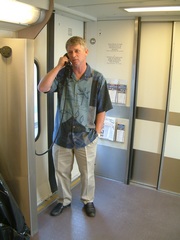
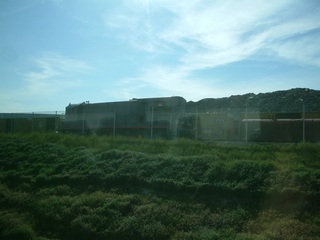
Dan Davis told us that they are
potentially going to have short length shuttle trains, 10 car
intermodal sets to inland empire distribution locations to alleviate
congestion. This inland truck depot might be 40 to 60 acres in
size. Another idea is to offer a discount for night
shipping. The southerly portion of the Alameda Corridor has 6
miles of track at grade From there it enters the 10 mile long
mid-corridor trench. At the southerly part of downtown LA, it
climbs back to ground level and splits toward the BNSF Railway or Union
Pacific Railroad yards which are close to one another. Mr. Davis
asked for questions, so I asked about the surface track which parallels
the trench for about 7 miles on the east side from Greenleaf to
Firestone. The reply was that they had constructed a bypass
track during construction to keep the original rail line
operational. Now it serves two puposes. First, it would be
used in case of a derailment in the trench. Second, Union Pacific
uses it for customers like Cargill along the line. At its
northerly point it veers away from the trench towards the east.
Another rider asked about how they would clear railroad equipment in
the event of a derailment. The trench has horizontal struts which
are removeable to keep the tops of the walls from falling in.
Rail cars which could not be rerailed in the trench could be lifted out
by removing 2 struts. Another feature of the Corridor is that the
rail is all continuous welded rail. The third question asked
about the disposition of the other two rail lines to the ports.
Mr. Davis replied that it is up to the individual railroad to maintain
their other route. At some point those two other routes may need
to be pressed into service again when the Alameda Corridor reaches
capacity. At this point, the train got to CP Thenard in Pacific
Harbor Line territory. PHL President Andrew Fox took over
commentary until the train reached its destination at 6th Street in San
Pedro. Mr. Fox noted that Pacific Harbor Line was formed in 1998
to take over from Harbor Belt Line. The ports bought all of the
physical rail assets from the railroads to level the playing field for
shippers. Prior to this, Harbor Belt Line was owned and run by the
Southern Pacific, the Santa Fe Railway and the Union Pacific. In
the past, a shipper could have problems getting their goods to or from
the port depending on where an individual railroad's track ended.
With the inception of PHL, shippers now had a neutral switching
railroad that could dispense reliable service at the largest port
complex in the western hemisphere which handles 14 million TEU
annually. In other words, the PHL leveled the playing field
between the ports and the railroads. At the commencement of
operations, PHL had 5 switching assignments which has grown to 31
assignments in 2005. At Long Beach Junction, one track segment
branches off towards the Port of Long Beach. Our train was
destined for San Pedro and continued under Anaheim Street and turned to
the west.
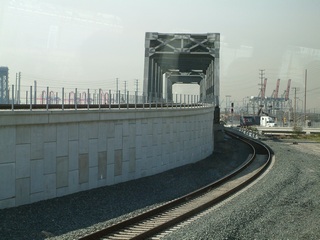
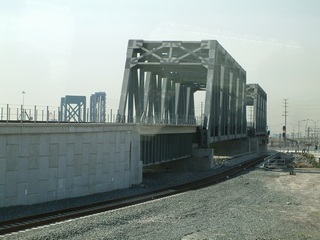
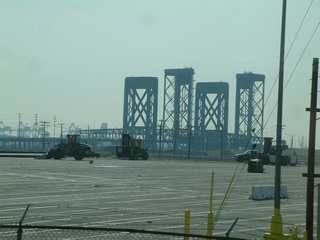
It was here that Mr. Fox talked about
the other signature feature of the Corridor, the Henry Ford Avenue
grade separation. This piece of railroad is a mile long, two
track railroad bridge over Dominguez Channel funneling rail traffic
over the Badger Bridge and onto Terminal Island and Pier 400.
This improvement cost $90 million. The truss bridge was
manufactured in Korea, shipped over to California and assembled.
There are also two surface rail lines which parallel the
overpass. One comes from the UP Mead yard (non-PHL territory) on
the east and the other comes off the Corridor and combines with
another track to form a wye. Both surface tracks then head to the
2 track Badger Bridge. According to Mr. Fox, 70% of the
containers at the ports are moved at Terminal Island, home to Global
Gateway South at Pier 300 and the Maersk Terminal at Pier 400. Hanjin
has its terminal at the site of the former U.S. Naval Station Long
Beach. NYK and Evergreen are on the west portion of Terminal
Island under the Vincent Thomas Bridge served by the TICTIF intermodal
yard. 40% of all containers in the United States go through the
LA/LB port complex.
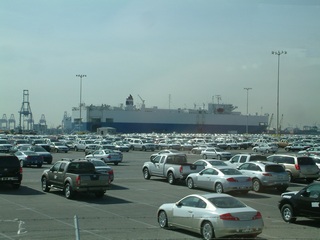
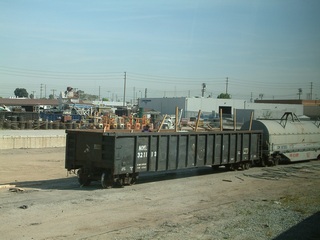
The special train continued along the
PHL non-signaled main track past transfer yard into
Wilmington. We saw large parking lots for Nissan imported
cars which are handled by DAS, Distributer Auto Services. Toyota
cars are offloaded at the Long Beach side. PHL handles 36,000
carloads and 750,000 intermodal cars annually. We passed nearby
the PHL Pier A yard, their carload yard, main offices and locomotive
facility.
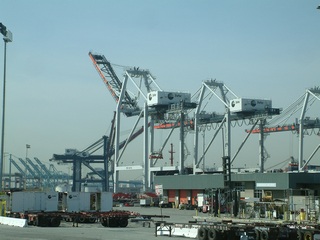
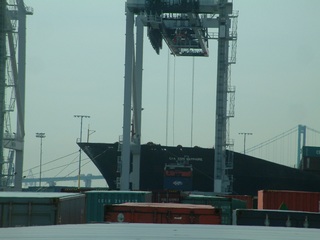
PHL has 125 employees, 21
locomotives, and 31 job assignments per week. Other passengers
were talking amongst themselves as well and I overheard author Joseph
Strapac talking about the one narrow guage railroad that was at the
port of LA. Past the PHL yard area, the track comes back
parallel to Harry Bridges Boulevard, or as Strapac called it "B"
Street, its former name. We passed the MItsui OK Lines Trans
Pacific terminal, one which does not load rail cars on their
property. After Figuroa Street, there is Conoco-Philips oil
refinery across John S. Gibson Boulevard and one of PHL's largest
carload customers.
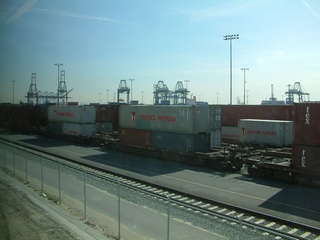
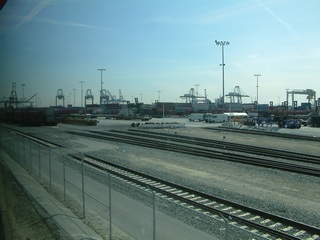
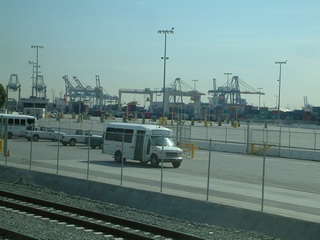
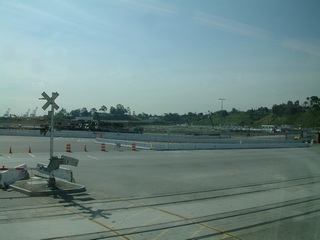
Further along the track we passed the
West Basin container facility, home to Yang Ming and China
Shipping. Mr. Fox noted that the name "Wilmington" came from
Phineas Banning, who had migrated from Wilmington Delaware. The
railroad turns towards the south and eventually passed under the
Vincent Thomas Bridge which connects San Pedro to Terminal
Island. The track then passes the Los Angeles World Cruise Center
and parallels Harbor Scenic Drive. At 9:20 AM the train stopped
in the crossing of 6th Street where all passengers detrained.
Page 2 APTA Alameda Corridor & Harbor
Cruise
Richard Elgenson RailNews
Network Site